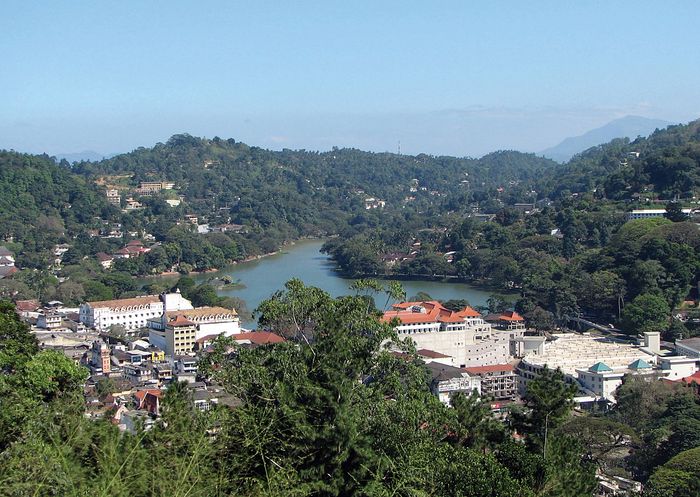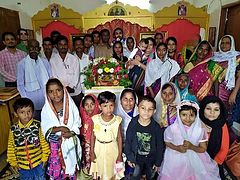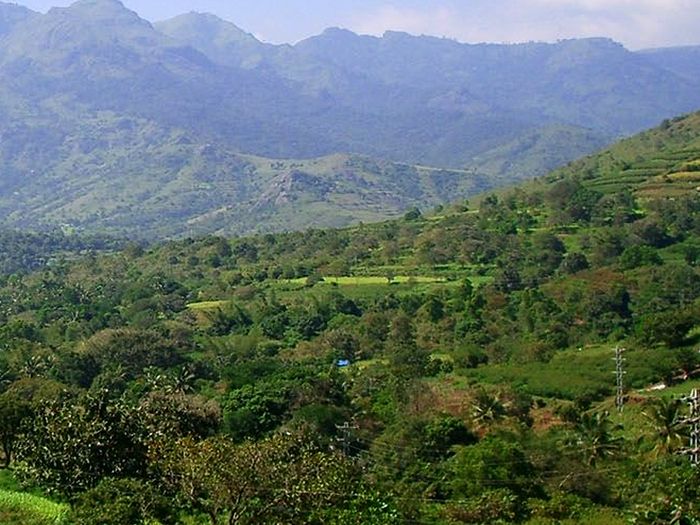 Pathanpuram. Photo: sanskriti-holidays.com
Pathanpuram. Photo: sanskriti-holidays.com
Life on the Mountain
Departing from Bethany Ashram, Father Andronik moved onto Pathanapuram, where he settled at Saint Stephen’s School, an English establishment led by a Malankara hierodeacon named Thomas.1 Father Andronik had befriended Father Thomas at a conference and was given some land at the school on which he could live and support himself. Also on site was a small convent that Father Thomas had founded, which had around ten sisters. After Father Thomas was ordained to the priesthood, Father Andronik often accompanied him on preaching and missionary trips and gave talks and homilies at the Sunday meetings held in the houses of parishioners.2
Not too long after his arrival in Pathanapuram, Father Thomas took Father Andronik to the village of Pattazhy near Madura Mala—the Sweet Mountain—and helped him establish himself near the peak on some land purchased from the local Malankara priest, Father John. Here, surrounded by tigers, snakes, monkeys, elephants, and a whole host of other exotic creatures, Father Andronik lived an austere monastic life in a wooden hut that had coconut leaves for a roof. By August 1933, he had eight acres of land and had built a small church where he could serve the Divine Liturgy. Father Andronik was not completely isolated at his skete, however, and occasionally preached in Pattazhy’s Malankara parish.3
Being only five miles from Pathanapuram and well-connected, Father Andronik was able to travel often to Travancore, as well as Calcutta, Bombay, Bangalore, and Goa, where he served the needs of the Russian émigré population. Around this time, Father Andronik received an ukaz from Paris stating that he had been appointed the Russian priest for the whole of India, and therefore pastor to the entire Russian diaspora on the subcontinent.4
It was during this period that Father Andronik had one of his most providential encounters. A young Anglican priest, Reverend Edgar Moore, who had been living at the Anglican ashram of Christa Seva Sangh in Poone, had become interested in Orthodoxy. He had met Father Andronik in Travancore and, deciding that he wanted to enter the Orthodox Church, sought him out at the skete and requested to live with him and study Orthodoxy. The two ended up living together for nine months, working in the garden and building the skete chapel. During the down time from work, Father Andronik spoke with Father Edgar about the Orthodox faith. They travelled often to go on preaching missions in the local area, being invited by the local Christians.5
 Father Lazarus and Abbess Elisabeth (Ampenov) on the left with sisters of Gorny Convent remained with ROCOR. Transjordan 1948-49. Photo: rocorstudies.org
Father Lazarus and Abbess Elisabeth (Ampenov) on the left with sisters of Gorny Convent remained with ROCOR. Transjordan 1948-49. Photo: rocorstudies.org
Due to the fact that his guest was an ordained Anglican priest, Father Andronik was unable to receive him into the Orthodox Church, as a bishop was required for this. Unsure of how to advance, their conundrum was finally solved when an anonymous benefactor sent a sum of money for Father Edgar to travel to Jerusalem and attempt to be received into the Orthodox Church by the Patriarch there.6 The two friends met again in 1951 at the New Kursk-Root Hermitage in Mahopac, New York. By then, Father Edgar Moore had become Archimandrite Lazarus and was soon to return to India and eventually become not only Father Andronik’s successor, but one of ROCOR’s most well-known missionaries.
Throughout the rest of his time on the mountain, Father Andronik was assisted by a young man Samuel, who, judging from the account given by Father Andronik in his memoirs, seems to have been received into the Orthodox Church. Samuel stayed at the skete and helped with the various household and garden tasks. He helped Father Andronik learn Malayalam and learned some Russian in return. Although Father Andronik served Vespers, Matins, and the Hours alone in his cell, Divine Liturgy was served in the chapel with Samuel chanting. He became proficient to a degree in Church Slavonic and was able to sing the responses to the litanies and prayers. Father Andronik mentions that the more complicated parts of the service, like the Antiphons, Cherubic Hymn, Creed, and the Anaphora, were translated into Malayalam and chanted according to Samuel’s own melodies. He read the Epistle in Malayalam from his own Bible.7
Samuel was a sickly young man and was often bedridden. On a number of occasions, during his illnesses, various saints appeared to guide him and heal his afflictions. Father Andronik recounts in his memoirs stories about the appearances of Saint Andronik, Saint Seraphim of Sarov, and Saint John Chrysostom to Samuel, all whom he recognised from icons in the chapel.8 Eventually, after a number of years with Father Andronik, he left the skete to get married on the advice of the local Indian Metropolitan and nothing more is known of him.
Father Andronik lived an austere life at his skete, maintaining the monastic rule to the best of his abilities. He performed his prayer rule and the divine services during the night, when it was cooler, and spent the days labouring in the garden or constructing various buildings at the skete, including the church. After his departure from India, he handed his skete over to the local Indian bishop, Metropolitan Divanyasios.9
Father Andronik was not the only Russian ascetic labouring on the Indian subcontinent. In 1936 there arrived from Jerusalem a certain Schemamonk Konstantin (Geshtovt).10 Father Konstantin was the son of a general who had commanded the Preobrazhensky regiment and, like Father Andronik, had fought in World War One. Exiled to Constantinople from Crimea, he became a circus acrobat and later an extra in Hollywood after immigrating to the United States.
He later travelled to Mount Athos, spending three years there but never settling, although he was tonsured into the Great Schema at a cell in Karoulia. He subsequently spent three years in Egypt—possibly Sinai—and some time in Jerusalem. It was from Jerusalem that Father Andronik received a letter from him, expressing his desire to join him in India. Considering that he mentioned that he was penniless, Father Andronik did not expect him to arrive anytime soon, but Father Konstantin turned up at the skete only two days after the letter, having had an adventurous journey through Syria, Mesopotamia, and the Persian Gulf.11
The presence of Father Konstantin did not provide much assistance to Father Andronik and his mission. He had contacted some friends at the monastery of Saint Panteleimon on Mount Athos who confirmed that Father Konstantin was not a member of their brotherhood and had gone to India on his own accord—in other words, without a blessing.12 Eschewing the life of hard work at the skete, Father Konstantin relocated to another mountain around twenty-five miles away and took up residence in a cave. He shortly afterwards built a hut and, after it was robbed, he burned it down and moved deeper into the jungle. He often visited Father Andronik’s skete, having walked through the night and, after spending the day there, walked the twenty-five miles back to his own dwelling place.
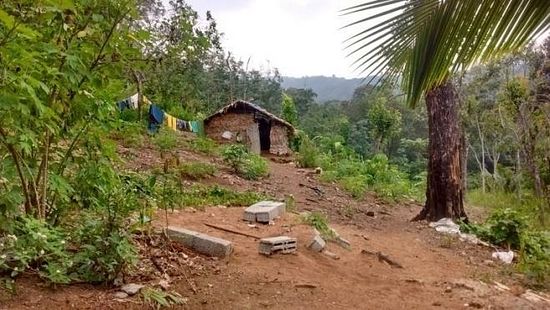 A Kani ‘Pera’ at Mukkothivayal Kani settlement, Agasthyar forest range. Photo: docplayer.net
A Kani ‘Pera’ at Mukkothivayal Kani settlement, Agasthyar forest range. Photo: docplayer.net
In his deep part of the jungle there lived a very primitive people, the Kanikkars. The Kanikkars had no medical care in their communities and died in very large numbers, which was a cause of great sorrow to Father Konstantin. Whatever influence that Father Andronik had over this schemamonk was lost as Father Konstantin took to wandering the cities of India, ostensibly raising money for the Kanikkar people, as well as for the Russian Orthodox Church. Father Andronik notes in his memoirs that he finds it unlikely that the money ever made it to either party.13
As the years progressed, Father Konstantin’s erratic behaviour was the cause of many issues for Father Andronik. While living at his own skete, Father Konstantin had started serving the Divine Liturgy, despite not being ordained. As he began to travel, this turned into a problem as Father Andronik heard reports of how he was hearing the confessions of the Russians and communing them at his liturgies. He was even known to baptise the children of the small Russian Orthodox communities. Father Andronik gave him a penance, which was carried out, but he was never sure if Father Konstantin was completely obedient to him. He informed the Russians that they were not to receive communion from Father Konstantin, while Saint John Chrysostom himself appeared to Father Andronik’s assistant Samuel and chastised him for taking part.14
During the Second World War, the wandering monk lived in a tent outside of an Air Force base near Bombay. He befriended some Americans, who later gifted him a small aircraft that he could use to fly around India on his fundraising journeys. It was this little plane that led to his untimely demise. In 1956, Father Konstantin crashed his aircraft into a large passenger airplane arriving in Bombay from Karachi and crashed into the sea, ending his life. Father Andronik notes that he was a man of undoubted piety, however strangely it was manifest.15
At the very same time that Father Andronik was dealing with Father Konstantin, he heard reports of another Russian Athonite schemamonk wandering the subcontinent and serving his own liturgies—Father Gavriil, also of Russian-German stock. Father Andronik writes in his memoirs that he was thankful that he never had to deal with him in person.16 The problems that such characters would have caused Father Andronik can be compared to the numerous pseudo-orthodox vagantes and ‘True Orthodox’ that are today present in many of the Church’s areas of missionary work, including India, causing confusion and dissension in the fledgling Orthodox communities.
The Second Delegation of ROCOR
In November 1937, the Synod of ROCOR sent its second delegation to India, with the firm intent of properly establishing a mission on the subcontinent.17 The Synod chose Archbishop Nestor of Kamchatka to lead the delegation and he was accompanied on this missionary trip by Archimandrite Nafanail (L’vov).18 Prior to their arrival in India proper and the arranged meeting with the catholicos, the delegation stopped in Ceylon in order to assess the situation there, as there were also a number of members of the Indian church living there.
It was in the capital city Colombo that the first contacts were made with people who expressed an interest in becoming Orthodox. These were a group of several native Anglican and Roman Catholic clergymen who stated that Orthodoxy was closer to their mentality than Western Christianity.19 One of the Anglican priests, Reverend Basil Jayawardene20 of the parish of Saint Paul the Apostle, arranged for the Russian delegation to use his church building for Orthodox services and it is reported that twenty-eight Anglican priests were present when Archbishop Nestor served the Divine Liturgy.21 Unfortunately, according to Father Andronik’s memoirs, since both Archbishop Nestor and Father Nafanail were weak singers, the interested Anglicans were not to be edified by the presence of ‘singing Russians.’22
Providentially, prior to the delegation’s departure for Travancore, Archbishop Nestor fell sick. It was during this delay that they were to meet another clergyman who was interested in joining himself and his flock to the Russian Orthodox Church—Padre Joseph Alvares.23 He was so enthusiastic about the possibility of becoming Orthodox that he readily signed his church building over to Archbishop Nestor and registered it as an ‘Orthodox Mission.’24
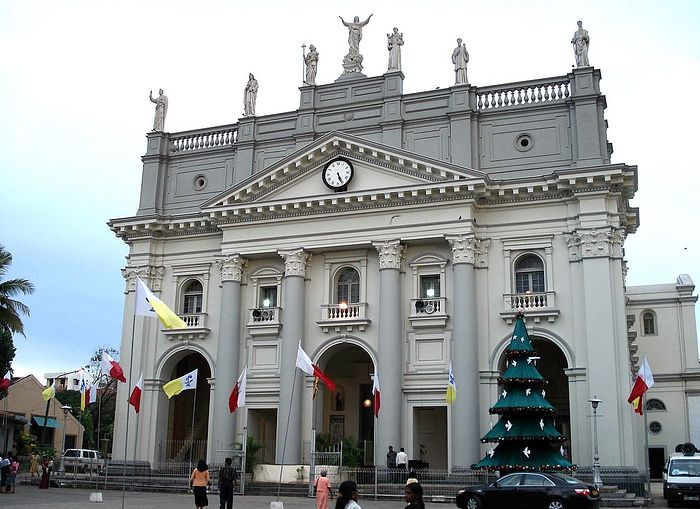 A Catholic church in Colombo: St. Lucia's. Photo: wikiwand.com
A Catholic church in Colombo: St. Lucia's. Photo: wikiwand.com
Now, while Father Georg Seide writes that Alvares was a Roman Catholic priest,25 it is almost a certainty that Alvares’s parish was actually the Cathedral of Our Lady of Good Death (‘Buona Morta’) in Hultsdorf, Colombo and that his flock of around seventy people represented the remnant of the Independent Catholic Mission,26 a group of around fifty parishes from Goa, South India, and Ceylon, led by Roman Catholic priest Padre Antonio Joseph Francisco Xavier Alvares,27 that broke away from the Roman Catholic Church in the 1880s and sought refuge in the Malankara Orthodox Syrian Church as a Western Rite mission. Alvares was consecrated as Metropolitan Mar Julius I and Padre Luis Mariano Soares, who is mentioned above, was also one of the other early leaders of this movement before joining the Chaldean Syrian Church.
By the time Mar Julius died in 1923, the ICM had already begun to disintegrate. Colombo had been the headquarters of the ICM after Mar Julius’ relocation to Ceylon but he returned to his native Goa towards the end of his life, effectively leaving the main body of his flock without a leader. To this end, the local community in Ceylon petitioned the Malankara synod to consecrate them a new bishop, a request that was turned down. Father Andronik mentions in his memoirs that this group sought to be received by the Ecumenical Patriarchate in 1900 after having separated from Rome, but this is most likely confusion on his part.28
The group had already left the Roman Catholic Church and been received by the Malankara Church in the 1890s, as has been mentioned above, but recent research shows that, in their attempt to find a bishop to pastor their flock of ten thousand faithful, the mission in Ceylon, represented by their lay leader Stephen de Silva,29 petitioned the Independent Catholic Church of the Philippines, also known as the Aglipayan Church, to consecrate a bishop for them in 1903, another request that was turned down.30
Therefore, it seems quite likely that they may have also contacted the Ecumenical Patriarchate around this period of time for the very reason. Father Andronik writes that Constantinople proposed to receive them by rebaptism, an offer that was unacceptable to them.31 In another twist to the tale of the ICM, the Malankara Church had actually sent some hierarchs on a long-awaited pastoral visit as recently as 1933 and 1937, when Catholicos Baselios Geevarghese II and Metropolitan Alexios Mar Thevodasios led a delegation that visited the ICM parishes and celebrated the Holy Qurbana32 at the cathedral.33 With this in mind, it cannot be ascertained what their true motives for being received into the Russian Orthodox Church were.
Following these encounters on Ceylon, the ROCOR delegation travelled to mainland India, where they met with Father Andronik at his skete. During their time in Travancore, they travelled extensively, celebrating the divine services, visiting local churches and institutions of the Malankara Church, and meeting with the catholicos and members of their Holy Synod. Archbishop Nestor explained to Father Andronik that his intention was to create a diocese that included India, Ceylon, and the Malay Archipelago, with the initial nucleus consisting of the four Russian Orthodox communities that Father Andronik ministered to.34
However, the positive experience that Bishop Dimitri had when he met with the Indian bishops was not to be repeated during the delegation’s visit. According to Father Andronik, a certain coolness had developed on the part of a faction within the Indian Church which was no longer well-disposed towards union with the Russian Church.35 The creative discussions that Bishop Dimitri was able to have were replaced by formulaic answers and useless, repetitive conversation. Father Georg Seide’s assessment of this is that the Anglicans and Roman Catholic missionaries, feeling threatened by the thought of a potential Orthodox mission being established in India, especially one with the cooperation of the local Christians, applied pressure on members of the Holy Synod in order to derail the negotiations.36
The question of the Council of Chalcedon also raised its head again. Archbishop Nestor wrote to the Synod from Kerala that the Indians had strong veneration for Dioscoros, Severos, and other Monophysite leaders and that it would be very dangerous and difficult to combat it.37 Prior to the meeting between the Russian and Indian hierarchs, Metropolitan Anastasii had sent copies of the dogmatic decrees and definitions of the seven ecumenical councils to the catholicos, but there seems to have been no change in the position of the Indians and that they felt the first three to be sufficient and would recognise the other four only if they did not interfere with the first three.
Following the disappointment of the meetings with the Indian synod, the attempt at starting a mission had come to a crisis point. The three Russians travelled from Travancore to Ceylon to re-assess the situation of the mission its possibilities, keeping in mind that the community of Padre Alvares had already signed their property over to the ROCOR delegation in the hope of becoming the centre of a mission in Ceylon. Father Andronik had already been nominated as official head of the mission, a position he had held de facto since his arrival in 1931. However, things did not go according to the hopes of the delegates: the three-month trip had emptied their coffers, forcing Archbishop Nestor to return to Manchuria, leaving behind Father Nafanail, with whom, as Father Andronik recounts, he had many disagreements.38
Despite these setbacks, Metropolitan Anastasii still had optimistic hopes for the mission and encouraged the rest of ROCOR to assist in some way. While in England to participate in the Walsingham Pilgrimage the following year, Archbishop Nestor formed the Brotherhood of Saint Thomas, which had Patriarch Gavrilo (Dozi) of Serbia39 as an honorary member. The Brotherhood was committed to securing financial, material, and moral assistance for the Russian mission in India.40 The Metropolitan also established the 25th December as a specific day for taking a collection for the mission in all parishes of the Russian diaspora. In order to facilitate the registration of the mission, Metropolitan Anastasii also tried to change Archbishop Nestor’s title from Kamchatka to Ceylon and Colombo.41
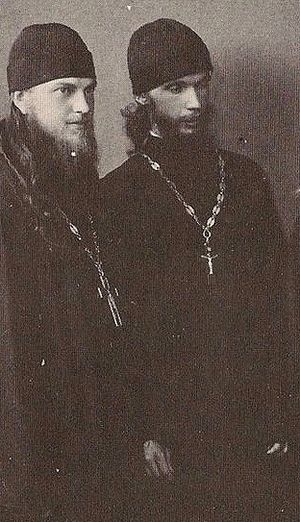 Priest-monks of Metropolitan Nestor: Nathanael (Lvov,) left and Philaret (Voznesensky). Harbin, 1930s. Photo: rocorstudies.org Father Nafanail continued to work at building the mission from the new church in Colombo, but this quickly descended into something of a farce. The parish, having been a Western Rite mission that not only maintained the Roman Rite, but also some Roman Catholic observations and devotions, refused to switch their liturgical practices to those of the Russian Orthodox Church, causing a major disagreement between them and Father Nafanail.42 It is not known, however, if the people had officially been received into the Orthodox Church by this point, or if it was just their building.
Priest-monks of Metropolitan Nestor: Nathanael (Lvov,) left and Philaret (Voznesensky). Harbin, 1930s. Photo: rocorstudies.org Father Nafanail continued to work at building the mission from the new church in Colombo, but this quickly descended into something of a farce. The parish, having been a Western Rite mission that not only maintained the Roman Rite, but also some Roman Catholic observations and devotions, refused to switch their liturgical practices to those of the Russian Orthodox Church, causing a major disagreement between them and Father Nafanail.42 It is not known, however, if the people had officially been received into the Orthodox Church by this point, or if it was just their building.
To make matters worse, the Roman Catholics, from whom the ICM had separated around half a century beforehand, litigated against the Orthodox mission in order to try and seize back the property, which was located in central Colombo and worth many thousands of rupees. Father Andronik even recounts in his memoirs an attempt made by the Catholics at physically taking the property by force. Some lawyers who were parishioners of Saint Paul the Apostle Anglican Church agreed to assist Father Nafanail by defending him in court.43
Not until after the Second World War did Father Andronik receive news of the final decision of the court, which awarded the property to Archbishop Nestor.44 Unfortunately, by this time, Archbishop Nestor was a metropolitan in the Soviet Union and Father Nafanail was serving the Russian refugees amongst the ruins of post-war Europe as Bishop of Brussels, so the opportunity had well and truly passed by. Today, the cathedral is in the hands of the Roman Catholic Church, as are the majority of the former ICM churches on Ceylon.
If the machinations of Roman Catholics and Anglicans could be offered as one reason for the ultimate lack of success at this stage in the mission, Father Andronik also offers another: Father Nafanail himself. It is quite obvious from reading his memoirs that he did not have a very high opinion of Father Nafanail, at whom he explicitly points the finger as a major factor in the mission’s failure. At the onset of the court case, some Russians and Greeks who were living in Colombo helped Father Nafanail find another location to hold services and even arranged a salary for him. According to Father Andronik’s memoirs, Father Nafanail undermined respect for himself by living in a manner unbefitting of a monk. Although he spares us the details, he alludes to “living freely.”45
Father Nafanail’s aforementioned lack of musical ability also contributed to his subsequent departure: Father Andronik occasionally travelled to Ceylon to direct the choir when Father Nafanail served, but when Pascha came around in 1939, he had other commitments in Travancore and was unable to assist with the choir. By the time it came to serve Paschal Matins, neither Father Nafanail or anyone else could even sing the Paschal troparion.46 Although this may be a somewhat exaggerated statement from Father Andronik, it nonetheless shows that the mission, while under Father Nafanail’s leadership, was not functioning at a relatively routine level. The Greeks hastened to put him aboard a steamer to Venice and gave him five British pounds for the journey, thus ending the ROCOR mission on Ceylon.47
Metropolitan Anastasii, following these developments, released Archbishop Nestor and Archimandrite Nafanail from the responsibilities of the Indian mission and tried once again to assign Archimandrite Filaret,48 but his departure for India again failed to materialise. By this time, war drums were beating in Europe and the attention of the Synod was taken away from India.

